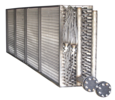When to choose steel or stainless steel tubes

There are times when steel or stainless steel is the best choice of materials for your tubes. Steel and stainless steel are also an option for fins, which I’ll talk about in my next blog post.
Let me break down the reasons why steel or stainless steel would be a better choice than copper or aluminum for tubing.
Tubes come in a variety of materials, including copper, aluminum, steel, and stainless steel. The material chosen for tubes depends on several factors:
- The corrosive properties of the steam or liquid travelling through the coils
- The corrosive properties of the external environment
- Steam pressure
- Piping, trapping and venting needs
- Installation and service requirements
- The budget for the project
Steel and stainless steel are both good options when steam pressure is too high for copper. When internal or external corrosion is an issue, steel or stainless steel tubes should also be used.
When selecting materials for your coils, you need to make sure the materials chosen for tubes, fins and other parts of the coil are compatible. When dissimilar metals, like copper tubes and aluminum fins, are used together, galvanic corrosion occurs. How quickly galvanic corrosion starts is based on variables like electrolyte conductivity, the amount of oxygen present, and the relative surface size of each metal.
If you are in need of a chilled water coil or steam distribution coil, Emergent Coils can help you select the best materials for your coils. If you are unsure whether steel or stainless steel tubes are right for your project, give us a call at 855-Coil-Now.
